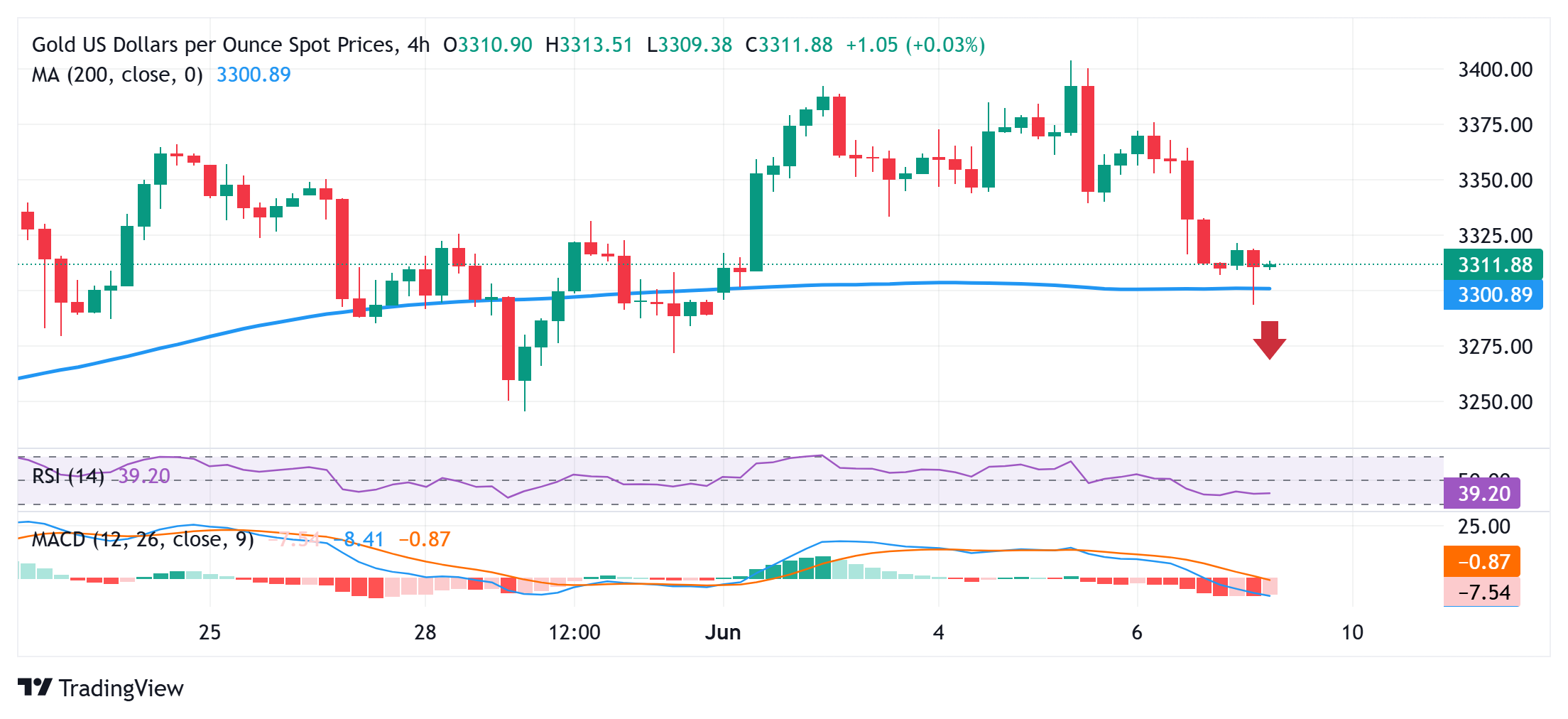Gold price refreshes daily top amid weaker USD; US-China trade talks eyed for fresh impetus
- Gold price reverses an intraday slide to sub-$3,300 levels amid a weaker USD.
- Rising geopolitical risks lend additional support to the safe-haven precious metal.
- Friday’s US NFP report tempered Fed rate cut bets and might cap the XAU/USD.
Gold price (XAU/USD) builds on its steady intraday move higher from sub-$3,300 levels, or a one-week low, and touches a fresh daily top during the first half of the European session on Monday The intraday bounce is sponsored by the emergence of fresh US Dollar (USD) selling, which tends to underpin the USD-denominated commodity. Apart from this, rising geopolitical tensions and trade-related uncertainties turn out to be other factors benefiting the safe-haven precious metal.
Traders, however, might refrain from placing aggressive bullish bets around the XAU/USD pair and opt to wait for headlines coming out of the key US-China trade talks in London. Furthermore, stronger-than-expected US jobs data released on Friday dampened hopes for imminent interest rate cuts by the Federal Reserve (Fed) this year, which could act as a tailwind for the USD and cap the non-yielding Gold price. This warrants some caution before positioning for further gains.
Daily Digest Market Movers: Gold price is underpinned by renewed USD selling, cautious market mood
- The closely-watched Nonfarm Payrolls report published by the US Bureau of Labor Statistics (BLS) on Friday showed that the economy added 139K new jobs in May compared to the previous month's downwardly revised reading of 147K. This, however, was still higher than the market expectation for 130K.
- Additional details revealed that the Unemployment Rate held steady at 4.2%, as anticipated, while Average Hourly Earnings remained unchanged at 3.9%, beating consensus estimates of 3.7%. The data prompted market participants to trim bets that the Federal Reserve will cut interest rates this year.
- The outlook keeps US Treasury bond yields across maturities elevated and exerts some downward pressure on the Gold price at the start of a new week. However, a combination of factors holds back the XAU/USD bears from placing aggressive bets and helps limit any further intraday downfall.
- Following the report, US President Donald Trump intensified his pressure campaign against Federal Reserve Chair Jerome Powell and urged him to cut rates by a full percentage point. Moreover, traders are still pricing in a greater possibility that the Fed will lower borrowing costs in September.
- This, along with concerns about the US government's financial health, fails to assist the US Dollar to capitalize on the post-NFP gains. Furthermore, an escalation in the Russia-Ukraine conflict, amid stalled peace talks, keeps the geopolitical risks in play and supports the safe-haven commodity.
- Top US and Chinese officials will meet in London on Monday for negotiations aimed at defusing the high-stakes trade dispute between the world's two largest economies. US President Donald Trump said last week that a call with the Chinese leader Xi Jinping resulted in a very positive conclusion.
Gold price technical setup warrants caution before positioning for any further intraday appreciating move

From a technical perspective, the Gold price showed an intraday resilience below the $3,300 mark and the 200-period Simple Moving Average (SMA) on the 4-hour chart. This makes it prudent to wait for acceptance below the said handle before positioning for deeper losses. The XAU/USD pair might then accelerate the slide below the $3,283-3,282 region, towards the $3,246-3,245 area (May 29 swing low) en route to the $3,200 neighborhood.
On the flip side, any meaningful move higher is likely to confront a stiff barrier and attract fresh sellers near the $3.352-3,353 horizontal zone. This, in turn, should cap the Gold price near the $3,377-3,378 resistance. A sustained strength beyond the latter, however, could trigger a short-covering rally and allow the XAU/USD bulls to make a fresh attempt to conquer the $3,400 round figure. The momentum could extend further towards the $3,425-3,430 region en route to the all-time top, around the $3,500 psychological mark touched in April.
US-China Trade War FAQs
Generally speaking, a trade war is an economic conflict between two or more countries due to extreme protectionism on one end. It implies the creation of trade barriers, such as tariffs, which result in counter-barriers, escalating import costs, and hence the cost of living.
An economic conflict between the United States (US) and China began early in 2018, when President Donald Trump set trade barriers on China, claiming unfair commercial practices and intellectual property theft from the Asian giant. China took retaliatory action, imposing tariffs on multiple US goods, such as automobiles and soybeans. Tensions escalated until the two countries signed the US-China Phase One trade deal in January 2020. The agreement required structural reforms and other changes to China’s economic and trade regime and pretended to restore stability and trust between the two nations. However, the Coronavirus pandemic took the focus out of the conflict. Yet, it is worth mentioning that President Joe Biden, who took office after Trump, kept tariffs in place and even added some additional levies.
The return of Donald Trump to the White House as the 47th US President has sparked a fresh wave of tensions between the two countries. During the 2024 election campaign, Trump pledged to impose 60% tariffs on China once he returned to office, which he did on January 20, 2025. With Trump back, the US-China trade war is meant to resume where it was left, with tit-for-tat policies affecting the global economic landscape amid disruptions in global supply chains, resulting in a reduction in spending, particularly investment, and directly feeding into the Consumer Price Index inflation.



